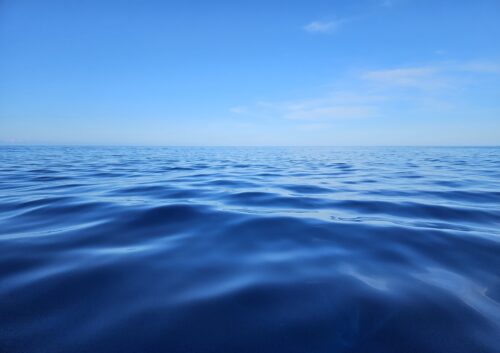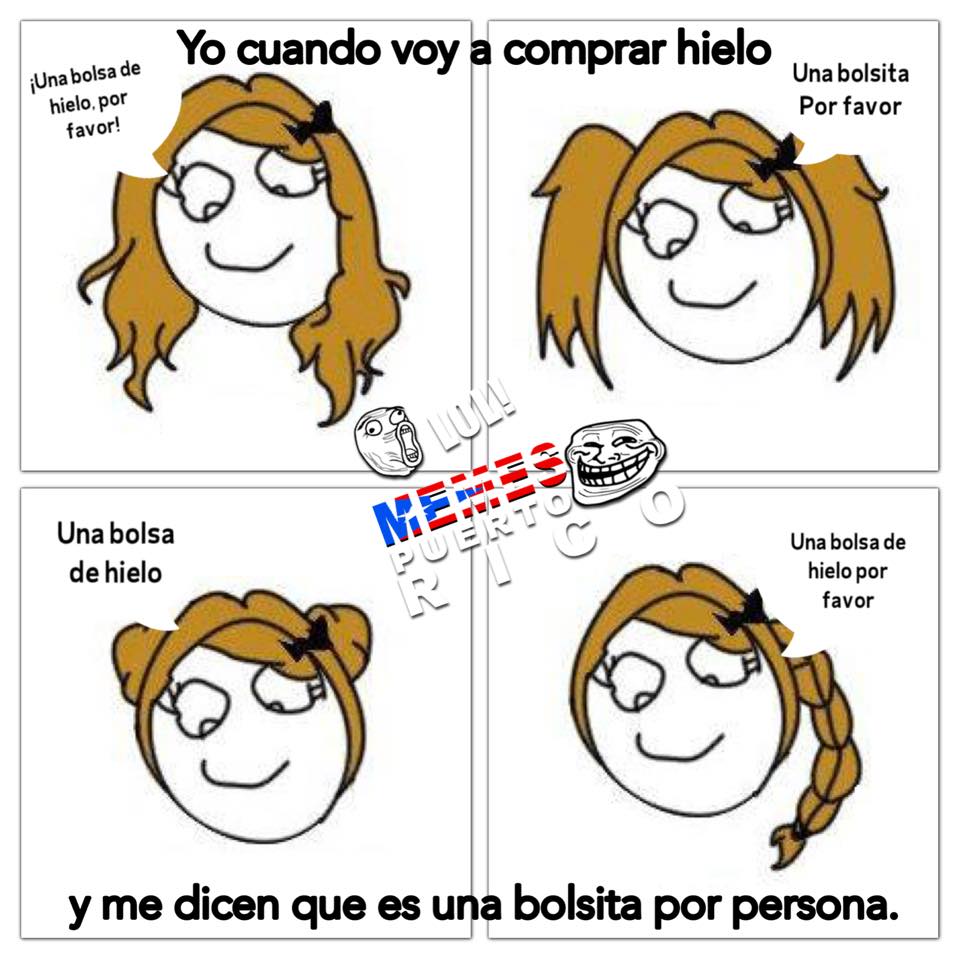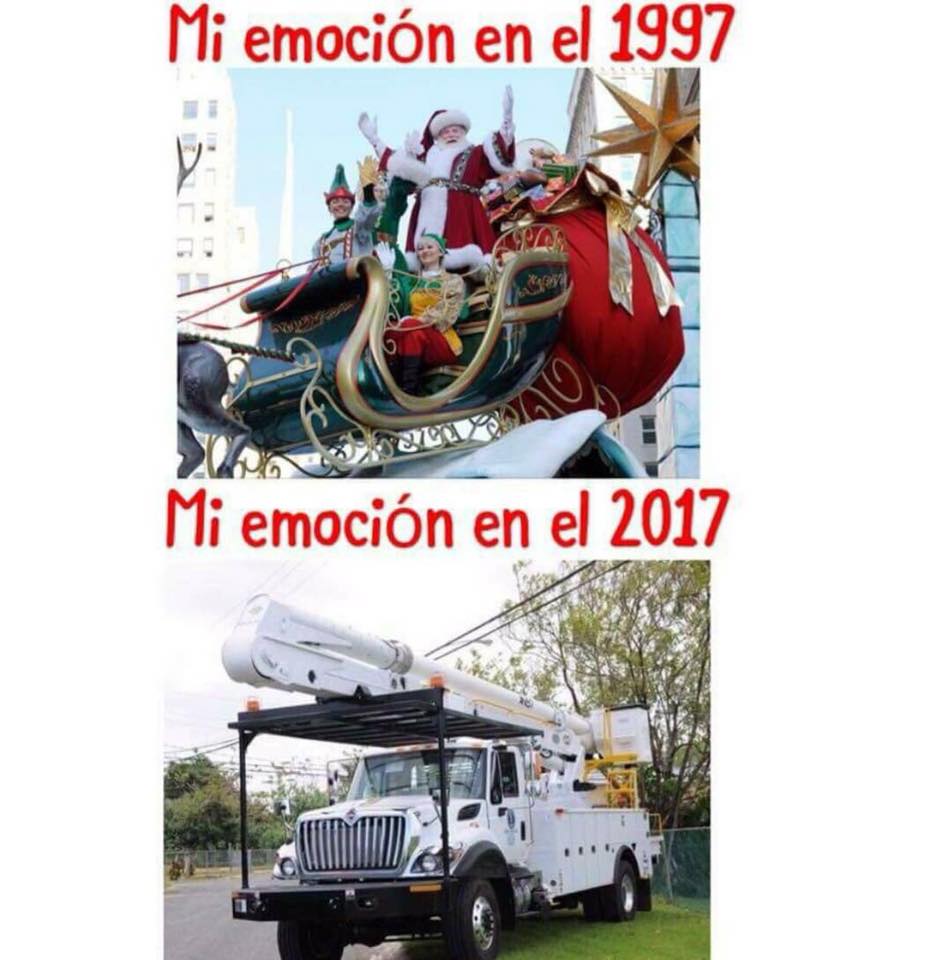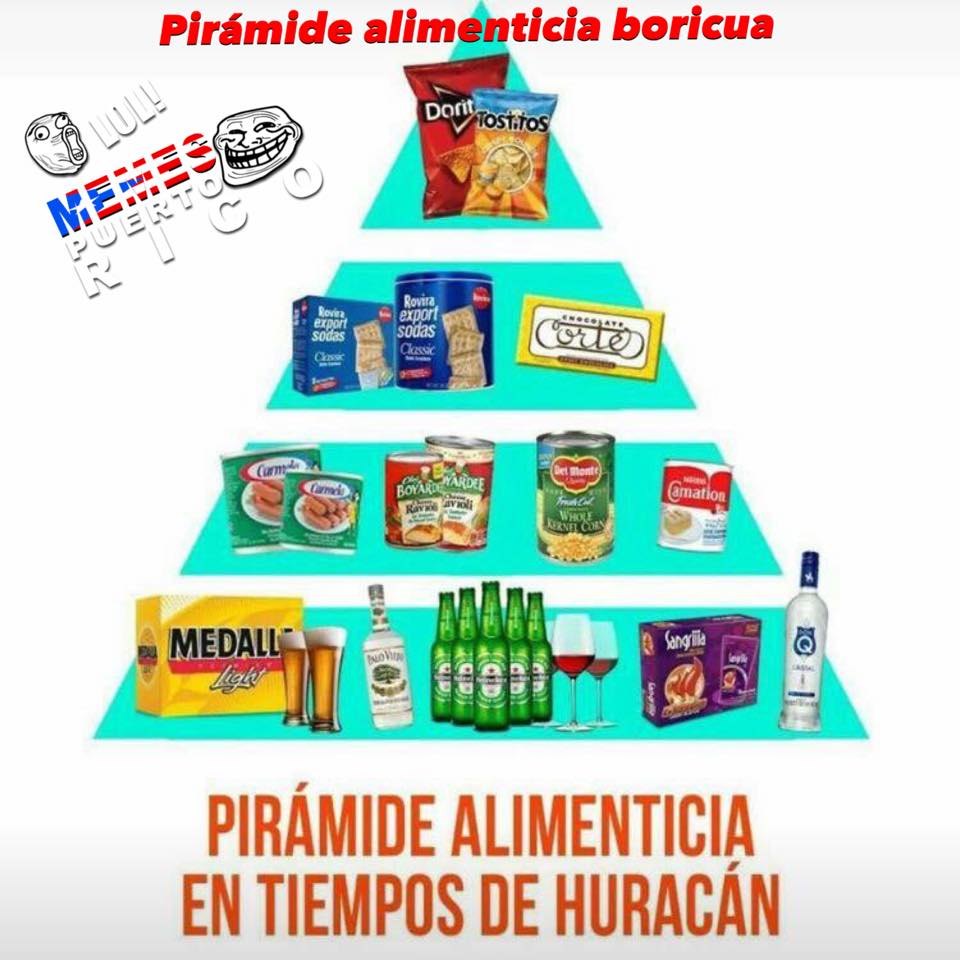In the Wake of Hurricane Maria, Memes Carry More Than a Little Truth
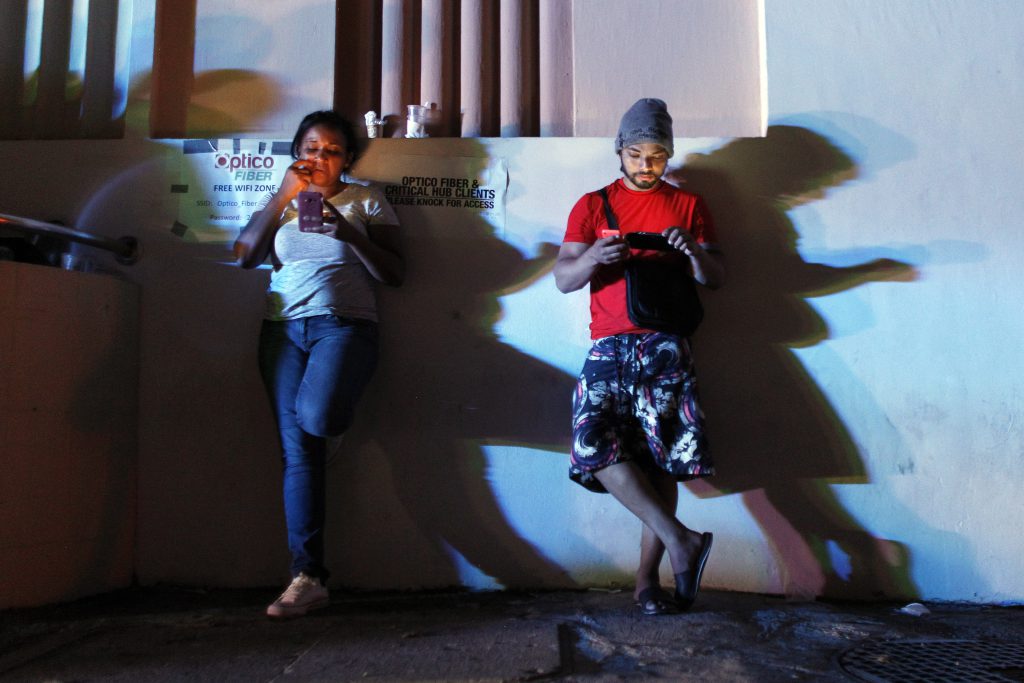
On September 20, 2017, Hurricane Maria struck the Caribbean—one of the worst in a long string of storms that ravaged the region last year. With unprecedented rainfall and powerful winds, the Category 4 storm carved a diagonal path through the center of the U.S. commonwealth of Puerto Rico. Hurricane Maria crippled the island’s already ailing public infrastructure, from the electrical grid to roads and emergency services, and took a grave human toll—estimated at over 1,000 disaster-related deaths. Almost eight months later, precariousness continues to plague everyday life, from ongoing power shortages and blackouts, to tense clashes with the police following recent community protests against austerity measures, to renewed debates regarding the island’s political status and potential U.S. statehood.
In the wake of the tragedy and trauma that Maria left on Puerto Rico, many locals turned to humor as one way to cope. As soon as people on the island got a sporadic internet signal, “memes” began to appear.
According to Merriam-Webster’s Collegiate Dictionary, a meme is “an idea, behavior, style, or usage that spreads from person to person within a culture.” In the context of social media, memes are often made up of an image or video, paired with text, that mocks reality and draws on shared insider experiences—even when those experiences are trying ones of struggle, frustration, desperation, and scarcity.
One post-Maria meme, for example, shows a cartoon of a woman sporting four different hairstyles, with the caption “me when I go to buy ice and they tell me that it’s one bag per person”—humorously suggesting a means to get around emergency rationing. The joke alludes to local pride in the ingenuity needed to make the best of a bad situation and a political system with rules that are often outside of community control. As often happens in life, uncomfortable, difficult issues get cloaked in humor to make them easier to bear and communicate.
As Puerto Rican anthropologists who study the island (one of us grew up there; the other on the mainland), we are concerned with how colonialism, environmental and economic uncertainty, and relations with the U.S. mainland continue to shape this unincorporated American territory. After Hurricane Maria, social media sites such as Facebook and Twitter became the best way to keep track of developing news on the island. In addition to the horrifying images and videos of the destruction, and pleas from countless families looking for lost relatives, we were struck by the rise of memes in our social media feeds. So we began to collect them.
Memes are more than just the sum of their images and texts. They reflect our daily lives. Their apparent simplicity and perceived innocence makes them fun, and irresistible to share, but that guise of frivolity also gives them the ability to illuminate hard truths. Memes, we have found, uniquely capture candid local reactions to post–Hurricane Maria conditions in Puerto Rico.
In one of the post–Hurricane Maria memes, two photos contrast very different circumstances for the Christmas season in Puerto Rico, two decades apart. One, labeled “my feelings in 1997,” shows Santa Claus on a sleigh, evoking nostalgia for abundance and happier days; “my feelings in 2017” shows a truck positioned to restore power lines. Many Puerto Ricans spent the past holiday season preoccupied with whether or when they would regain electricity.
The post-Maria power outage was the longest blackout in U.S. history, leaving the majority of the island’s 3.4 million people in the dark for months; the process of restoring the island’s grid has been fraught with work delays and controversial contracts. Although 98 percent of the island’s power is reportedly back online now, it still comes and goes. In April, seven months after Maria, there was another islandwide blackout.
Another meme pokes fun at U.S. food aid efforts. The usual food pyramid recommends a base of grains followed by a healthy dose of produce, meat and dairy products, and a tiny portion of sugary and high-fat foods. Locals, including San Juan Mayor Carmen Yulín Cruz, criticized the Federal Emergency Management Agency’s (FEMA) food parcels to the island as unhealthy and culturally inappropriate. People expressed frustration that they were not able to choose their own food. For example, there were no plantains, which are used, among other things, to make a Christmastime staple called pasteles (based on green plantains and stuffed with meat).
The parody “pyramid of Puerto Rican food in hurricane season” shows a base of alcohol (beer, rum, wine, and sangria) followed by canned food products and chocolate, crackers, and chips. The meme’s suggestion of alcohol as the most-consumed food after the hurricane was especially cutting, given elevated rates of suicide and depression on the island.
In a more politically charged meme, someone fries up a roll of Bounty paper towels as a “thank you” to President Donald Trump after his visit to the island in October 2017. The ironic hashtag #blessed graces the corner of the screen. While people were going hungry on the island and languishing in an increasingly toxic environment without power, clean water, or basic necessities, Trump infamously threw paper towels out into a crowd during a press event. Many described the act and Trump’s statements, implying that Hurricane Maria was not a “real catastrophe,” as insulting and belittling of people’s suffering. Trump defended himself as simply “having fun” with the crowd. The meme points to a perceived double standard in the government’s response to humanitarian crises affecting American citizens on the mainland—such as the one in the wake of Hurricane Harvey in Texas—versus in Puerto Rico in the aftermath of Hurricane Maria.
A different meme plays on the fact that after Hurricane Maria, more than 135,000 Puerto Ricans left the island in search of better living conditions. This major wave of depopulation was resented by some locals as a selfish abandonment of the homeland during a dire time of community need. A pair of images teases migrants by contrasting them—cold and alone, without family—on the U.S. mainland (illustrated by the frozen villain from the horror movie The Shining) with the happy families living in the eternal tropical summer of Puerto Rico.
Today some of the post-hurricane Puerto Rican diaspora are returning to the island, despite slow reconstruction, continued resource shortages, and inadequate health care. (There are pressing concerns about the sources and level of aid needed, especially in terms of medical care for older people.) And even though the majority of new migrants relocated to nearby Florida, with its familiar tropical climate, a portion did move to the colder cities of the U.S. Northeast. And many have had to contend with uncertain housing prospects in hotels through FEMA’s Transitional Sheltering Assistance Program. (After warning that housing assistance would end in April for those displaced by Maria, FEMA recently extended the deadline to June 30.)
Social media spaces, including Twitter feeds and YouTube video diaries, have become important platforms for Puerto Rican narratives about how Hurricane Maria continues to impact day-to-day life on the island. Alongside the important work of reconnecting networks, providing recovery support, and facilitating donations, memes allow locals to vent their frustrations and tensions through a lighter medium.
Memes are emblematic of a larger community spirit. More than making people laugh, they have the potential to create communities of common minds. In post-Maria Puerto Rico, memes have been a vehicle for local agency in the midst of vulnerability. Rather than accepting defeat, Puerto Ricans broadcast their endurance and resistance through humor. Meme-makers and meme-sharers are part of a larger effort of people trying to write their own stories and interpret their own experiences. The future of Puerto Rico is complex and undetermined, but Puerto Ricans, through memes as well as numerous grassroots and other creative initiatives, are determined to be the authors of it.





























